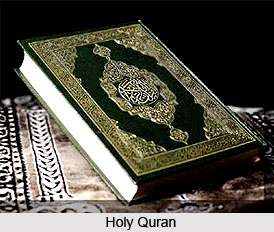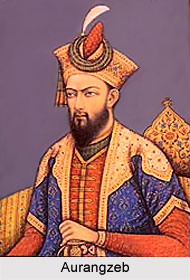 Education of Zebunissa was of the highest order and not left lacking in anything. Zebunissa`s education began at four and a half years of age. The child showed exemplary powers of retention and a gift for learning from a very early age. It was the Muslim custom to have the Holy Quran learnt by heart from beginning to end. The final examination was as much a test for the teacher as for the pupil. The child had to read or recite verses from the Quran, particularly certain chosen passages, before a gathering of specially-invited male guests. If the pupil did well, the master was honoured and he was awarded a ceremonial garment and other gifts. He would also read a benediction over certain dishes, which were prepared for distribution among the poor and needy. Zebunissa was gifted with the extraordinary memory of her ancestor Akbar. Even before she learnt to read and write she was able to memorize works read to her. By the time she was seven she knew the Quran by heart. It was not customary to celebrate this achievement for a daughter, but for Zebunissa, her father, the Mughal Emperor Aurangzeb made an exception. The proud father commemorated the occasion with unparalleled splendour in his capital of Aurangabad. He rewarded her female tutor, Hafiza Maryam, 30,000 pieces of gold. He added a spectacular new dimension to the occasion by having the royal guard present arms. Silver coins were thrown to the crowd, and all the public offices were closed for two days. He also undertook to educate Hafiza Maryam`s son Inayat Ullah, whom he later raised to some of the highest positions in the land.
Education of Zebunissa was of the highest order and not left lacking in anything. Zebunissa`s education began at four and a half years of age. The child showed exemplary powers of retention and a gift for learning from a very early age. It was the Muslim custom to have the Holy Quran learnt by heart from beginning to end. The final examination was as much a test for the teacher as for the pupil. The child had to read or recite verses from the Quran, particularly certain chosen passages, before a gathering of specially-invited male guests. If the pupil did well, the master was honoured and he was awarded a ceremonial garment and other gifts. He would also read a benediction over certain dishes, which were prepared for distribution among the poor and needy. Zebunissa was gifted with the extraordinary memory of her ancestor Akbar. Even before she learnt to read and write she was able to memorize works read to her. By the time she was seven she knew the Quran by heart. It was not customary to celebrate this achievement for a daughter, but for Zebunissa, her father, the Mughal Emperor Aurangzeb made an exception. The proud father commemorated the occasion with unparalleled splendour in his capital of Aurangabad. He rewarded her female tutor, Hafiza Maryam, 30,000 pieces of gold. He added a spectacular new dimension to the occasion by having the royal guard present arms. Silver coins were thrown to the crowd, and all the public offices were closed for two days. He also undertook to educate Hafiza Maryam`s son Inayat Ullah, whom he later raised to some of the highest positions in the land.
Aurangzeb personally followed the religious education of his daughter and would listen carefully when he asked her to repeat certain verses from the Quran. It is said that he embroidered these passages on cotton caps with his own hand and sold them in the bazaar. The money he earned he distributed among the poor. Aurangzeb was not against the prevalent secular education system, but he had serious reservations about it. Thus, the education he gave his first-born was strict and methodical. Nothing was left to improvisation or the personal whims of the teacher, for he was conscious of the faults he perceived in his own education. From childhood, Zebunissa was treated like a prince and not a princess. She was taught all the subjects that Aurangzeb considered important, including the arts of war and administration, which were normally only taught to boys. Young Mughal princes were thoroughly grounded in these two subjects. However, she did better than all her male counterparts in theology and literature. Aurangzeb made it a point to find better teachers for his children than he had had, men like Mullah Abdul Latif of Sultanpur in the Punjab, who was well versed in the sciences and had been the first religious master of Dara Shikoh, and Aitmad Khan who, according to Khafi Khan, taught Zebunissa the Quran by heart.
 Although her father was against the custom of Arabic being the medium of education and would have preferred it to be in the language of the country, Zebunissa learnt this language in four years under the sage Shah Rustam Ghazi. She also mastered Persian, her mother`s language. Finally, she was taught calligraphy. Aurangzeb remembered with pleasure her apprenticeship with the Persian calligrapher Mir Sayyid Ali al Husseini of Tabriz, who later became Superintendent of the Imperial Library, or Kitabdar, to Aurangzeb. Under him Zebunissa soon learnt how to write in the different styles of calligraphy: Shikast, Nastaliq, and Naskh. As a reward for her first works, her father presented her one of the famous writing-desks made in the Deccan, which were inlaid with ivory and tortoiseshell and enamelled with gold and silver (the plainer ones were inlaid with copper). She valued her desks highly, and they would always accompany her on her travels. They even appear in some of her portraits.
Although her father was against the custom of Arabic being the medium of education and would have preferred it to be in the language of the country, Zebunissa learnt this language in four years under the sage Shah Rustam Ghazi. She also mastered Persian, her mother`s language. Finally, she was taught calligraphy. Aurangzeb remembered with pleasure her apprenticeship with the Persian calligrapher Mir Sayyid Ali al Husseini of Tabriz, who later became Superintendent of the Imperial Library, or Kitabdar, to Aurangzeb. Under him Zebunissa soon learnt how to write in the different styles of calligraphy: Shikast, Nastaliq, and Naskh. As a reward for her first works, her father presented her one of the famous writing-desks made in the Deccan, which were inlaid with ivory and tortoiseshell and enamelled with gold and silver (the plainer ones were inlaid with copper). She valued her desks highly, and they would always accompany her on her travels. They even appear in some of her portraits.
When she grew older, Hafiza Maryam taught her mathematics and astronomy. The clear winter nights must were ideal for studying the skies above the high towers of Daulatabad with the help of long telescopes brought from Holland by foreign merchants. And along with astronomy, of course, Zebunissa took an interest in astrology, a very important and much studied science among the Mughals since Humayun. It was often confused with astronomy. Astrology requires minute and knowledgeable calculations along with the study of stars, which Zebunissa`s enquiring mind picked up easily. She must also have witnessed her father consulting various divining objects before going into battle or taking other important decisions. Astrology influenced the Princess very strongly, though she was affected more by its poetic than its lunar aspect. This is often reflected in her works; her metaphysical questioning sometimes delves deeply into religious dilemmas and torturous self-analysis.
Thus Zebunissa, the eldest daughter of Aurangzeb, was a well-read and learned lady due to the all-round education provided to her by her father and her own intellectual inclinations.



















